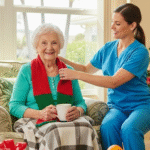The most common type of lymphedema is called “secondary lymphedema” and is believed to affect 1 in 1000 Americans. It can be a very difficult diagnosis to accept as a patient as it is a chronic condition that will likely always need maintenance therapies. This can be very frustrating for people who were once active. Many people survive cancer only to be left with an issue that can decrease their quality of life. The lymph system is damaged by trauma, cancer, or surgery and the result is dysfunctional drainage of lymph fluids causing extensive swelling, usually to an arm or leg.
The lymph system is an important part of the body’s immune system. It is a series of ducts, nodes, and organs that carry fluid containing proteins, salts, water, and white blood cells that fight infection throughout the body. Lymph ducts have one way valves that carry the fluid through the nodes which filter foreign substances like tumor and bacteria cells. Lymph nodes are found in the neck, chest, armpit, groin, and abdomen. If you are having surgery where the lymph system will be damaged or disrupted in some way the doctor will arrange for you to see a lymphedema specialist after surgery. You will be fitted for a compression garment and be taught how to manage the condition. Patients need to be very protective of an extremity with lymphedema, even a small cut in the skin can cause a serious infection due to the inability of the body to move the bacteria out through the filter system.
Unfortunately as a home health nurse it was my experience to come across many patients who have lymphedema and really do not know what to do about it. Some have had no trauma to the lymph system but have chronic swelling of the legs with no cardiac or kidney related reasons. They may lack the resources to travel to and from a clinic several times a week and since most therapies to treat it are considered maintenance, Medicare will not pay for the services in the home long term. Skilled nursing home care agencies that are trained in lymphedema therapy may come to the home until an open wound is healed and at that point the patient will transition to outpatient. The primary treatment is compression garments, some are layered wraps, some are made for when you are sleeping, some for when you are awake, most are hard to put on by yourself. Lymphedema pumps can often be obtained through insurance for the home. Some home care agencies can help by sending staff to help apply the compression garments. Try to keep your sodium intake under 2000mg daily, elevate your legs 2-3 times daily above the level of your torso for 30 minutes. Applying properly fitted compression garments first thing in the morning before swelling can occur is the most successful way to manage this common problem.




